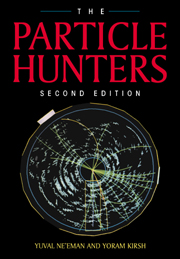Book contents
- Frontmatter
- Contents
- Preface to the first edition
- Preface to the second edition
- 1 The building blocks of the atom
- 2 Physical laws for small particles
- 3 The discoveries of the 1930s and 1940s
- 4 Particle accelerators — or from hunters to farmers
- 5 Strange particles
- 6 Basic forces and the classification of particles
- 7 Conservation laws
- 8 Short-lived particles
- 9 To the quarks — via the eightfold way
- 10 More quarks — or charm, truth and beauty
- 11 The Standard Model and beyond
- Appendix 1 Properties of semi-stable particles
- Appendix 2 The Greek alphabet
- Name index
- Subject index
3 - The discoveries of the 1930s and 1940s
Published online by Cambridge University Press: 05 August 2012
- Frontmatter
- Contents
- Preface to the first edition
- Preface to the second edition
- 1 The building blocks of the atom
- 2 Physical laws for small particles
- 3 The discoveries of the 1930s and 1940s
- 4 Particle accelerators — or from hunters to farmers
- 5 Strange particles
- 6 Basic forces and the classification of particles
- 7 Conservation laws
- 8 Short-lived particles
- 9 To the quarks — via the eightfold way
- 10 More quarks — or charm, truth and beauty
- 11 The Standard Model and beyond
- Appendix 1 Properties of semi-stable particles
- Appendix 2 The Greek alphabet
- Name index
- Subject index
Summary
In 1932, with the discovery of the neutron, it seemed that the picture of the atomic world was complete. This picture featured four elementary particles (photons, electrons, protons and neutrons), the properties of which are summarized in Table 3.1. The atomic nucleus was composed of neutrons and protons, and the behaviour of the electrons surrounding the nucleus was well explained by quantum mechanics (which successfully explained many other phenomena in the atomic and sub-atomic world). Actually, this picture was not a perfect one. There were several unsolved problems such as the process of beta decay and the nature of the force holding the nuclear components together. The theories which attempted to solve these problems predicted the existence of additional particles, and the experimentalists searched for and discovered them — along with other particles that the theoreticians had not predicted. The particle research of the 1930s and 1940s is conveniently described under four headings:
(1) discovery of the positron and understanding the role of antiparticles;
(2) the neutrino and the ‘weak force’;
(3) Yukawa's theory of the ‘strong force’;
(4) discovery of the muon and pion.
The experimental research on the elementary particles in that period depended quite heavily on cosmic rays, which are briefly described in the next section.
- Type
- Chapter
- Information
- The Particle Hunters , pp. 63 - 88Publisher: Cambridge University PressPrint publication year: 1996



